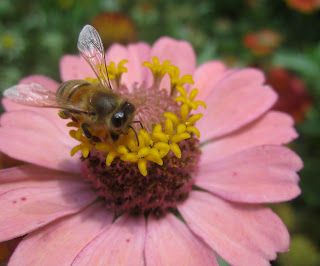 |
| mountain mint flowering in my backyard |
Years ago, my family and I lived in Harris County, Georgia, on approximately 24 acres of land, much of which was mixed pine and hardwoods--hickories, oaks, loblolly pine. We lived there for almost seven years before we decided that we should move back to Texas (which turned out to be not such a great move for my career, but that's another story). On those almost twenty-four acres of land we raised a few chickens (most of which eventually fell prey to the local wildlife) and planted several garden areas. One of our friends, a professor of environmental horticulture with the University of Florida, brought us some mountain mint one year, and we planted it at the edge of our lawn, where it flourished. The plant was rather unassuming, three or four feet high, with inconspicuous flowers, but to our delight, it attracted the most interesting and diverse pollinators. We had never before seen so many different bees and wasps. When we returned to Georgia several years later, we purchased more mountain mint at a local native plant garden and then, a couple of years later, transplanted a plug of that mint at our new home in Louisiana.
The mountain mint is now blooming here where we have planted it at the back of our property near pine trees. However, I have yet to see any pollinators on the mint. I am waiting for those fascinating and diverse bees and wasps to show up. Will they come?
 |
| mountain mint flowers |
I thought that our vegetable, herb, and flower blooms would be covered with pollinating wasps and bees. In the spring, I left a large patch of white clover in the yard for the bees, expecting to see huge numbers of bees buzzing the oval blooms. Maybe five or six bees seemed to be in the patch at one time. When I go outside in the mornings to check on my vegetables and flowers, I see a few bees and wasps among the tomato vines, in the squash blossoms, and among the hydrangeas, but not the numbers I expect. Where are all the little pollinators?
Have they all gone the way of the honeybee? In 2006, there was a honeybee crisis as bee keepers experienced huge colony losses. Lots of reasons were advanced for what became known as colony collapse disorder: modern transportation (airplanes carrying pathogens and diseases to new territory); drought, which made bees more susceptible to diseases and pathogens; a fungus, nosema ceranae, which is believed to have been introduced into the United States in 2007; pesticides; varroa mites; among others.
More recent studies indicate that pesticides play a bigger role in honeybee decline than companies that manufacture pesticides would want us to know--most specifically,
"a new class of pesticides called neonicotinoids." Neonicotinoids were developed in the 1990s
as a relatively less-toxic alternative to
pesticides that seriously harmed human health, [and]... soon
became the world’s fastest-growing pesticide class and an integral part
of industrial agricultural strategy. In the United States alone,
neonicotinoid-treated corn now covers a total area slightly smaller than
the state of Montana.
Like earlier pesticides, neonicotinoids disrupt insects’ central
nervous systems. But unlike earlier pesticides, which affected insects
during and immediately after spraying, neonicotinoids spread through the
vascular tissues of plants. They’re toxic through entire growing
seasons, including flowering times when bees consume their pollen. ["Controversy Deepens Over Pesticides and Bee Collapse," an article by Brandon Keim in Wired, 6 April 2012.]
The chemical and pharmaceutical company Bayer manufactures neonicotinoids, marketed as imidacloprid, an
additive to many products, including flea control products, termite control products, roach bait gel, aerosol sprays for bedbugs, rose and flower food, and on and on and on.
As with the diminished menhaden that I described in my
previous post, the primary reason for the disappearance of pollinators is ..... really, our inability or lack of will to connect
the dots that demonstrate the interconnectedness of the choices we make
to control pests and to grow our food. As
Rowan Jacobsen, who
has written a book about the honeybee crisis, reminds us:
Honeybee health is inextricably linked to the health
of the entire
environment, including our own. If we can create systems of domestic
food production that take their cues from the cycles of nature, and let
honeybees play the roles they evolved to play, then the system will take
care of itself. But if we continue to push the system farther and
farther out of equilibrium by relying on chemical shortcuts and fossil
fuel intervention to fix the inevitable breakdowns, then we will never
get off the crisis treadmill. [quoted in The New York
Times' article: "Saving
Bees: What We Know Now," 2 September 2009]
Of course, we all want to control the pests that eat our plants and that bite and infect our pets. But at what cost? We use Frontline Plus on our cats to control fleas and mites. I just looked at the description of the product that we keep in a kitchen drawer; Frontline Plus contains
fipronil, a pesticide that seems to work similarly to imidacloprid, if I can take
Wikipedia's description at face value. Fleas that bite our treated cats die because their central nervous system is affected by the pesticide. Fipronil is also poisonous to bees and other wildlife and has been associated with colony collapse disorder. I'm not putting fipronil on my roses, so I doubt that pollinators are being affected by my cats' flea treatment, but, again, I am reminded of how each of us makes decisions every day that have consequences we least expect. Were I to choose to control the pests on my flowers and herbs with one of these pesticides, I would also be destroying the pollinators that visit those blooms.
 |
| Leaf-foot (stink) bugs on my tomato stakes |
We have had a terrible recurring infestation of catepillars eating the foliage of our vegetables and flowers. To control them, Tom applied Bacillus thuringiensis (Bt) on the plants. Bt is a bacterium that is considered an environmentally-friendly control for caterpillars. However, it does kill
all caterpillars, and that includes the caterpillars of our most beautiful butterflies. I was distressed to discover two dead Swallowtail butterfly caterpillars on the dill that grow near the zinnias that were treated. Also, food crops have now been genetically modified to contain the Bt gene, and the consequences of these modifications might be enormous: the monarch butterfly, for one, has been greatly affected, and some studies suggest other detrimental effects that merit further study.
These are the consequences of the choices we make to control pests, and I am becoming increasingly aware of how my own individual choices are part of those global effects. When I found those dead Swallowtail butterfly caterpillars on my dill, I decided to grow a butterfly garden next year in which I will allow caterpillars to munch to their hearts' content. I've gotten over some of my squeamishness about directly targeting pests and squashing caterpillars with my fingers. I just returned from my garden with fingertips covered with green caterpillar guts. I've even been catching stink bugs with my own hands (ugh) and crushing them with my gardening shoes. And this morning I actually took out the shop vac and hoovered up an entire clump of leaf-foot stink bugs that were hanging out together on the top of some of the tomato stakes. Now that must have been a humorous sight.
Of course, farms that grow huge quantities of vegetables cannot afford to send out scores of folks every day to pinch bugs from their plants, but we have got to find a way to achieve balance in how we control the bugs that compete with us for our food.


















